The Sea Gypsies of Surin Island
The Wake of the Tsunami Brings Both Help and Harm to Thailand’s Mogen People
By Antonio Graceffo
 One of the
smallest ethnic minorities in Asia, The Sea Gypsies were virtually unknown
by the outside world until the 2004 tsunami ravaged South East Asia. One
of the most amazing stories reported by the international press was that
not one of the Sea Gypsies died. Having lived in close communion with the
sea for centuries, the Sea Gypsies knew well in advance when the tsunami
would hit, and they all took refuge in the mountains. Soon after this story
broke, international attention was focused on these fascinating people who
would have preferred to remain anonymous. Aid began pouring in, changing
the economic dynamic, as well as the diet of the Mogen. The press came.
The Tourists came. And soon, government regulations came, which altered
their way of life, forever.
One of the
smallest ethnic minorities in Asia, The Sea Gypsies were virtually unknown
by the outside world until the 2004 tsunami ravaged South East Asia. One
of the most amazing stories reported by the international press was that
not one of the Sea Gypsies died. Having lived in close communion with the
sea for centuries, the Sea Gypsies knew well in advance when the tsunami
would hit, and they all took refuge in the mountains. Soon after this story
broke, international attention was focused on these fascinating people who
would have preferred to remain anonymous. Aid began pouring in, changing
the economic dynamic, as well as the diet of the Mogen. The press came.
The Tourists came. And soon, government regulations came, which altered
their way of life, forever.
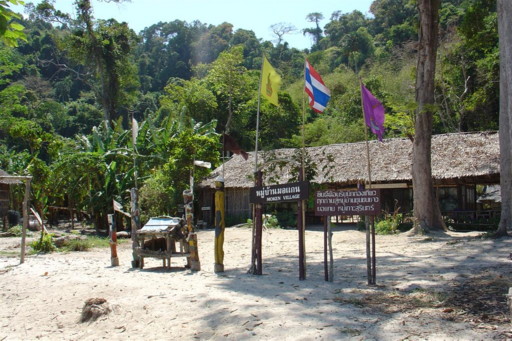 The
Sea Gypsies are a nomadic people, who traditionally spend much or all of
their lives living on their boats. They inhabit the waters off of Burma,
Thailand, Malaysia, and Borneo. Called Chao Lei (or sea people) by the Thais,
the Sea Gypsies refer to themselves as the Mogen people. Since the tsunami,
there has been some movement on the part of the Thai government to issue
Thai citizenship to the Mogen. As a result, the politically correct name
for the Mogen has been changed to Thai Mai, or new Thai.
The
Sea Gypsies are a nomadic people, who traditionally spend much or all of
their lives living on their boats. They inhabit the waters off of Burma,
Thailand, Malaysia, and Borneo. Called Chao Lei (or sea people) by the Thais,
the Sea Gypsies refer to themselves as the Mogen people. Since the tsunami,
there has been some movement on the part of the Thai government to issue
Thai citizenship to the Mogen. As a result, the politically correct name
for the Mogen has been changed to Thai Mai, or new Thai.
Thailand’s Mogen population is centered around three settlements, near Phuket Island.
The history of the Mogen people is a bit of a mystery. It is generally accepted that they came originally from Indonesia, although many scholars believe they came from India. They speak a unique language, which borrows heavily from Malay as well as Thai. They have no written language and no recorded history. The Mogen themselves, don’t know the story of their origin.
 On Surin
Island, near Phuket, there is a village of 59 Mogen families. The island
has been declared a national park and has a tourist resort at one end. The
Mogen area, while not off limits, is not part of any package tours, and
is accessible only by longtail boat from the tourist resort. The Thai government
is trying to prevent the Mogen village from turning into a human zoo, like
the artificial hill tribe villages near the Burma border.
On Surin
Island, near Phuket, there is a village of 59 Mogen families. The island
has been declared a national park and has a tourist resort at one end. The
Mogen area, while not off limits, is not part of any package tours, and
is accessible only by longtail boat from the tourist resort. The Thai government
is trying to prevent the Mogen village from turning into a human zoo, like
the artificial hill tribe villages near the Burma border.
Although about twenty percent of the villagers have converted to Buddhism, the Mogen traditionally follow an animistic belief system, which centers on ancestor worship. They have two important festivals each year to pay respects to their ancestral dead. They also float traditional boats, called gabong, in the hopes of washing off their sins, illness, and bad luck with the purity of the sea water.
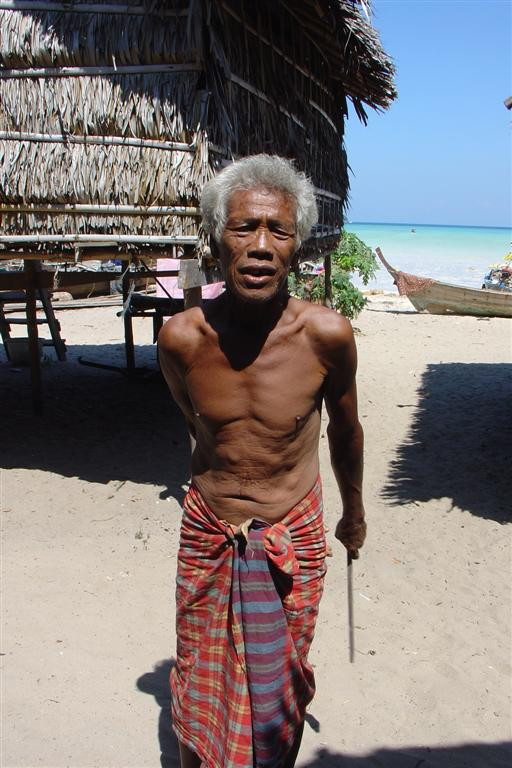 In interviews,
several Mogen said simply “the fish told us about the tsunami.”
The 62 year-old village headman, Suarama Mogen, said that their animist
lore had warned them of the tsunami, so when they saw the sea recede they
knew what was coming. Many Mogen men got in their boats and paddled to the
other side of the island rescuing tourists. Some Mogen, out at sea, actually
rode it out. They knew how to paddle out beyond the wave and how to negotiate
the whirlpools which followed.
In interviews,
several Mogen said simply “the fish told us about the tsunami.”
The 62 year-old village headman, Suarama Mogen, said that their animist
lore had warned them of the tsunami, so when they saw the sea recede they
knew what was coming. Many Mogen men got in their boats and paddled to the
other side of the island rescuing tourists. Some Mogen, out at sea, actually
rode it out. They knew how to paddle out beyond the wave and how to negotiate
the whirlpools which followed.
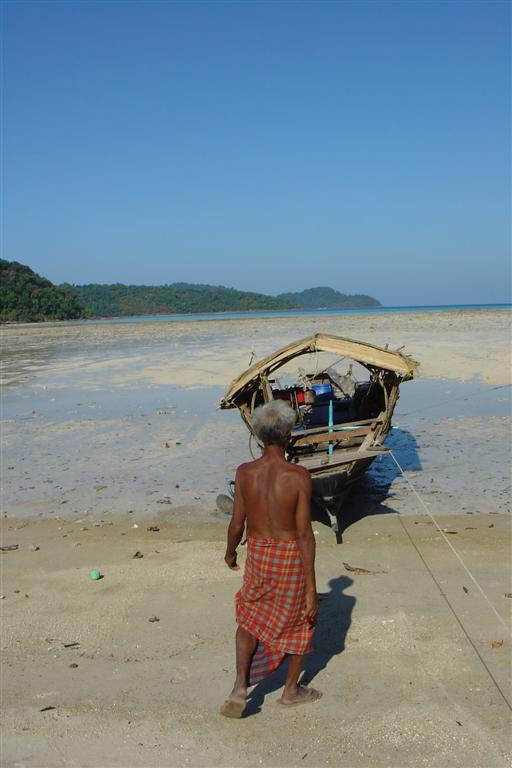 The
village entrance is adorned with lobong, spirit poles, bearing the faces
of supernatural beings who protect the village. The Mogen live in single
room houses on stilts, made of woven bamboo. The family’s most important
possession, a gabong, the traditional boat, is made from a hollowed out
tree. In former times they were rowed, but now they have longtail engines.
The boat is like a floating house with everything necessary for daily life
including cooking.
The
village entrance is adorned with lobong, spirit poles, bearing the faces
of supernatural beings who protect the village. The Mogen live in single
room houses on stilts, made of woven bamboo. The family’s most important
possession, a gabong, the traditional boat, is made from a hollowed out
tree. In former times they were rowed, but now they have longtail engines.
The boat is like a floating house with everything necessary for daily life
including cooking.
The Mogen traditionally made their living by fishing and harvesting sea products. The men and boys practice diving, plunging to great depths to forage for sea cucumbers, oysters, pearls, and shell fish. Their lifestyle and behavior depends on the monsoon season. If the wind is from north east they go to the deep sea for fishing. If the wind is from north west, they build a temporary, communal hut to escape the bad weather.
During the rainy season, they forage in the jungle for wild sweet potatoes which are an important staple of their diet, particularly when fish is unavailable.
They sell pearls and certain valuable shells to get money to buy those things that they couldn’t make themselves. In the past, they sold these trade goods through Chinese middlemen who often took advantage of them.
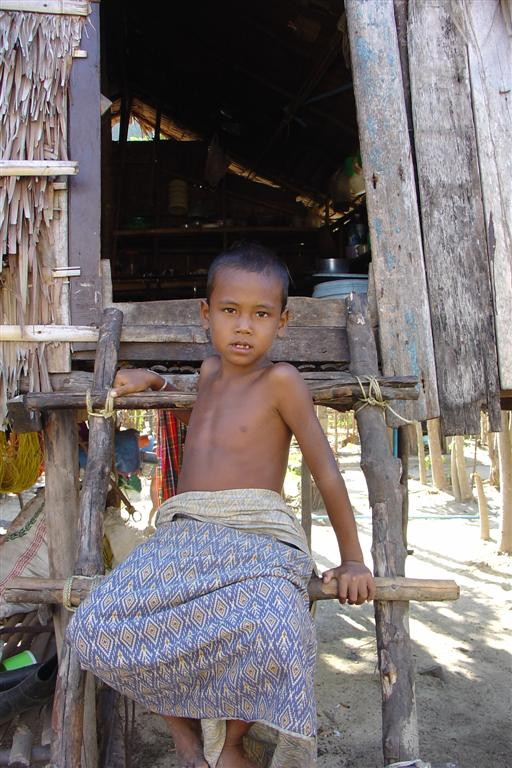 Although
every Mogen, regardless of sex, could do every job in he village, in general
men do diving, fishing and foraging. Women care for children and home, as
well as cooking and repairing fishing gear. Now, because of post tsunami
tourism, the families also produce handicrafts to sell to the visitors.
Although
every Mogen, regardless of sex, could do every job in he village, in general
men do diving, fishing and foraging. Women care for children and home, as
well as cooking and repairing fishing gear. Now, because of post tsunami
tourism, the families also produce handicrafts to sell to the visitors.
Drawings made by Mogen children, hanging in the visitors center, show just how close the Mogen are to the sea. Every picture contained at least one boat. Even more noteworthy was the fact that the pictures showed every fish under the sea. There were squid, jelly fish, blow fish, and crabs. At a young age, the children had already learned to appreciate and identify marine life.
Before the tsunami there was a small government school on the island, which ran through grade four. The school’s funding had just ended, and the school would have closed. But now, because of direct aid, sponsored by the royal princess foundation, there are two full-time Thai teachers living in the village, and all twenty-five of the village children attend school five days per week. The princess is well known for her benevolence and aid to Thailand’s tribal people and many ethnic minorities.
 The tsunami
has been a double-edged blessing for the Mogen. The Mogen never ate rice
until the tsunami relief rations arrived. Now rice has become part of their
diet, so they have to find more ways to obtain cash to exchange for rice.
They have a school, they have additional income from selling handcrafts.
They are covered under a medical project, also through the influence of
the princess, which brings doctors to the village to see after the children.
The down side is that they are no longer self-sufficient. Historically,
the Mogen way of life did not include financial aid. As they derive more
and more of their income from sources on land they lose their spiritual
connection with the sea which was the central tenet of their lives.
The tsunami
has been a double-edged blessing for the Mogen. The Mogen never ate rice
until the tsunami relief rations arrived. Now rice has become part of their
diet, so they have to find more ways to obtain cash to exchange for rice.
They have a school, they have additional income from selling handcrafts.
They are covered under a medical project, also through the influence of
the princess, which brings doctors to the village to see after the children.
The down side is that they are no longer self-sufficient. Historically,
the Mogen way of life did not include financial aid. As they derive more
and more of their income from sources on land they lose their spiritual
connection with the sea which was the central tenet of their lives.
One reason why the Mogen were nomadic in the past was that they would move in order to avoid depleting the fish population in a given area. By remaining in the village, the Mogen have lost their nomadic ways. Now, because they no longer move around, they have become an environmental hazard to the very sea which gave them life. To conserve the diversity of aquatic life, the government has imposed fishing restrictions on the Mogen, limiting them to fishing during the monsoon season. During the dry season many of the men go to work as boat-handlers in the national park. The women work as cooks and house keepers. A number of Mogen have been traveling to the mainland seeking work as laborers. The Mogen have lost the freedom of the sea and exchanged it for wage labor.
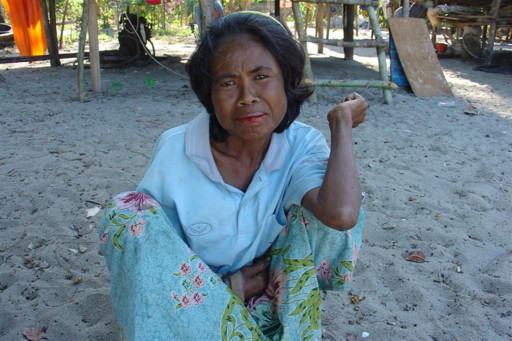 The majority
of the Mogen do not posses a Thai ID card so they have no legal right to
work. As a result they are horribly underpaid and often exploited.
The majority
of the Mogen do not posses a Thai ID card so they have no legal right to
work. As a result they are horribly underpaid and often exploited.
When they don’t go to sea, the Mogen don’t have a lot to do. They spend much of the day sitting in the cool shade, under their houses, playing games. The adults were playing western cards for money. Some children were playing a Chinese card game with tiny cards. Others where playing Asian varieties of chess and checkers on homemade boards.
At a pleasant looking house, we stopped to talk to Kai Mogen, who told us he wasn’t sure of his age. Checking his house registry, we ascertained he was 39 years old.
Kai explained that he was lucky enough to possess a Thai ID card. Because of restrictions on fishing he can no longer make his living from the sea, so he supplements his income by carving model boats out of wood and selling them to tourists. During tourist season he can earn more money with souvenirs than he used to with fishing. But tourists really only come six months out of the year. Because the island is now a national park there are also restrictions on cutting wood from the forest, which makes it difficult to build boats or make souvenirs. Now the Mogen have to buy the wood they use to make boats. The boats sell for between one and two hundred Baht, so the profit margin can’t be tremendous, especially when you consider the time it takes to do the painstaking craft work.
Kai tells us his family lived in the boat till he was seven. Later, after converting to Buddhism, he went to the mainland to become a monk. He was able to receive three years of primary school education. Now he can read and write Thai, and he helps the other villagers with their legal documents and paper work. He tells us he is the only adult in the village who can read.
According to Kai, Mogen girls and boys usually marry between age 13 and 15. Most families only have 2-3 children due to the high rate of infant mortality. Of Kai’s many children, only one son, age 8, survived.
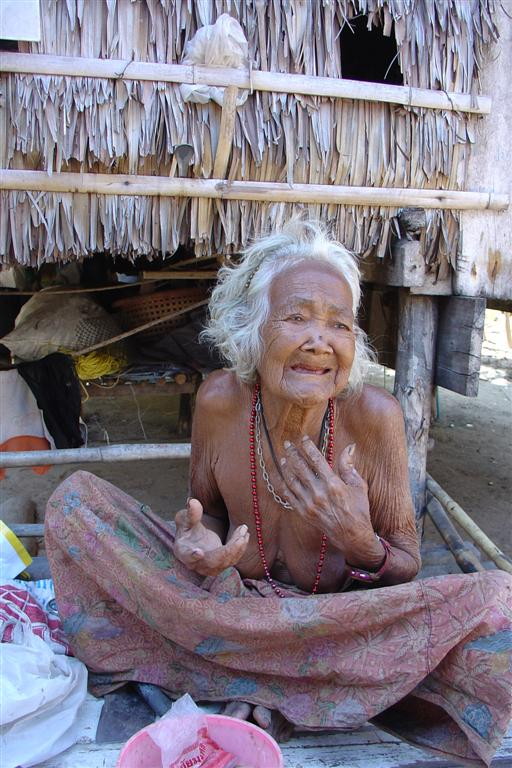 The
most common justification that the Thai government gives for not issuing
the Mogen with ID cars is that there is no way of proving which Mogen are
from Thailand and which are illegal immigrants from Burma. In the case of
rural Thai villages, where births and deaths happen at home and where people
often lack documents, the word of the headman of the village is taken as
law. The headman registers the names of each family member who belongs to
the village. In the case of the Mogen, however, the government doesn’t
allow this method of registration. According to Kai, who has been in the
village for 32 years, the only new families in the village were Mogen transplanted
by the government after the tsunami.
The
most common justification that the Thai government gives for not issuing
the Mogen with ID cars is that there is no way of proving which Mogen are
from Thailand and which are illegal immigrants from Burma. In the case of
rural Thai villages, where births and deaths happen at home and where people
often lack documents, the word of the headman of the village is taken as
law. The headman registers the names of each family member who belongs to
the village. In the case of the Mogen, however, the government doesn’t
allow this method of registration. According to Kai, who has been in the
village for 32 years, the only new families in the village were Mogen transplanted
by the government after the tsunami.
At the other end of the village in an open air school, beneath a bamboo roof we met twenty-eight year-old Chanra, a bright and caring Thai man, employed by the princes foundation. For the last two years he has been living in the village working as a teacher.
One of the many barriers in educating tribal children, or in this case, ethnic minority children, is that they have never known the rigidity of the classroom. Living with their parents they have absolute freedom apart from the work they do on the sea. “It was hard at first keeping the children in school.” He told us. “The first day, I was writing something on the board. When I turned around, the children were all naked, playing in the sea.”
Recently, Chanra was recognized by the Thai press as being the first teacher to have success with the Mogen children. Chanra said, “The parents have to trust you. If the parents trust you, then they will make the children go to school.” Chanra told us that when he first came to the village, many children came to school one day but were absent the next. On those days Chanra went to each house to follow up and find out why the children had missed class. With time, Chanra became a member of the Mogen community. “I live and teach on their schedule.” He told us. “They have no concept of time or days or hours. In fact, in Mogen they can’t even use numbers, they use tallies for counting.”
“During the monsoon season I go to sea with the fathers. I fish, I even dive for sea products.” Chanra told us he had no knowledge of diving before but now he can do it quite well. “Of course I can only do half of what the Mogen can do. Even the children are all expert divers.” This statement is even more amazing when you consider that most Thai people can’t even swim.
“Most of the children have snorkeling gear now. They picked it up off of the sea bottom when it was lost by tourists. They use it when they forage for sea products.
The villagers come to Chanra with all of their problems, whether it be dealing with the government, health problems, or trading.
“They called me when an old woman was dying. I could do nothing…” Said Chanra sadly. On the wall of his small hut, next to the school he had a large box of simple medicines he used to treat the children when they were ill.
“Lack of knowledge is really the biggest healthy problem in the village. One man had two babies die because he fed them milk tablets.”
“They are much poorer than the Muslim fishermen on the mainland. Everything is too expensive for them.” Chanra told us that fuel is the single largest expense of the Mogen families.
“When the big ships come, the Mogen come and get me at the school house. We go out by boat and trade fish for fuel.”
In addition to teaching Thai literacy and basic math, Chanra also teaches the children about hygiene. “The Mogen bathe in the sea.” He told us. “When they found out about soap they used laundry detergent for everything, even to wash their bodies.” When the children come to school in the morning, they have inspection, and Chanra makes sure they have showered, brushed their teeth, and cut their nails.
The Mogen would be too poor to purchase notebooks and pencils for the children. Luckily, all of the stationary is provided by the princes foundation. The princess also provides the children with a hot lunch.
“A boat comes in around eleven o’clock with fresh fruit, vegetables, rice and meat from the mainland and I cook lunch for the children.” Chanra said that many of the health problems including high infant mortality come from lack of sanitation. “There is an initiative now to teach the Mogen to use the toilet. “Normally, they just go wherever they are.” Poor diet is also a factor. “They have a severe lack of fruits and vegetables. When we make lunch for them we make sure they get a lot of vitamin-rich fresh foods.”
Before the tsunami there was no initiative to educate the Mogen adults. Now Chanra runs an adult Thai language and literacy program during monsoon season. “Less than 10% of the people in the village know how to read.”
In the single classroom, the children range in age form 3 to 13. The children can study until age 14. If the child misses school because the parents go out to sea for an extended period of time then they are welcomed back in the village school no matter what their age. “We study Monday to Friday, but I am never free. “laughs Chanra, “Because on weekends, the children come to visit me.”
The trust instilled in Chandra by the Mogen adults, speaks of the incredible job he is doing with the children. The one major failing in the curriculum is that the children are only being taught to read and write in Thai. Normally, tribal education initiatives strive to create a writing system for the tribal language, so that the tribe can record its history.
 Since the
tsunami, the Mogen are no longer strictly nomadic. They don’t earn
their living exclusively from the sea. They are no longer self-sufficient,
depending heavily on aid money. Their children are getting a rudimentary
Thai education. Many have become Buddhist. More and more of the Mogen are
resigning themselves to wage labor. The men use motors on their boats, forcing
them to earn cash to pay for petrol. The children have learned to use snorkeling
gear when they dive. The Mogen children travel with their mothers each day
to the resort. While the mothers clean up after the tourists, the children
watch TV and interact with the foreigners, learning foreign ways. In spite
of government protections, more and more tourists come to gawk at the Mogen.
They bring with them outside cultural influence and a dependence on cash.
Since the
tsunami, the Mogen are no longer strictly nomadic. They don’t earn
their living exclusively from the sea. They are no longer self-sufficient,
depending heavily on aid money. Their children are getting a rudimentary
Thai education. Many have become Buddhist. More and more of the Mogen are
resigning themselves to wage labor. The men use motors on their boats, forcing
them to earn cash to pay for petrol. The children have learned to use snorkeling
gear when they dive. The Mogen children travel with their mothers each day
to the resort. While the mothers clean up after the tourists, the children
watch TV and interact with the foreigners, learning foreign ways. In spite
of government protections, more and more tourists come to gawk at the Mogen.
They bring with them outside cultural influence and a dependence on cash.
If no writing system is developed for the Mogen the language will be lost.
The tsunami didn’t kill them, but it remains to be seen how much longer the Mogen can survive.
Check out Antonio's website - http://speakingadventure.com/
Get his CDs and DVDS at http://cdbaby.com/cd/graceffo
Get Antonio's books at amazon.com . . .
-
The Monk from Brooklyn
-
Bikes, Boats, and Boxing Gloves
-
The Desert of Death on Three Wheels
-
Adventures in Formosa

 Cougar WebWorks
Cougar WebWorks 